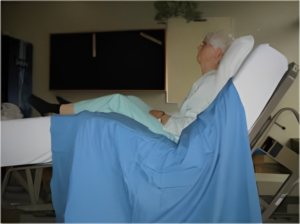Table of Contents
Fowler’s Positions in Nursing and Their Benefits
Fowler’s position is a common patient position in medicine and nursing that involves raising the head of the bed at an angle between 15 and 90 degrees. It is named after George Ryerson Fowler, a surgeon who used it to treat peritonitis in the late 19th century
Fowler’s position has various applications and benefits for patients with different conditions and needs. It can improve breathing, drainage, comfort, and digestion. However, it also has some risks and complications that nurses should be aware of and prevent.
Types of Fowler’s Positions
There are four main types of Fowler’s positions, depending on the angle of elevation and the position of the legs. They are:
Low Fowler’s position:

The head of the bed is raised at 15 to 30 degrees. The legs may be straight or slightly bent. This position is often used for resting, administering drugs, and feeding through a tube.
Semi Fowler’s position:
The head of the bed is raised at 30 to 45 degrees. The legs may be straight or slightly bent. This position is often used for respiratory treatments, recovery from abdominal surgery, and labor and delivery.
Standard Fowler’s position:
The head of the bed is raised at 45 to 60 degrees. The legs may be straight or slightly bent. This position is often used for surgery of the head, chest, and shoulder, as well as respiratory distress syndrome.
High Fowler’s position:

The head of the bed is raised at 60 to 90 degrees. The legs may be straight or slightly bent. This position is often used for eating, swallowing, defecating, X-rays, and breathing difficulties.
Benefits of Fowler’s Positions
Fowler’s positions have many advantages for patients, such as:
- Improving breathing by allowing more chest expansion and reducing pressure on the diaphragm.
- Reducing the risk of aspiration and regurgitation during tube feeding or oral intake.
- Enhancing drainage of blood, fluid, and secretions from the head, chest, and abdomen.
- Increasing comfort and reducing pain during certain procedures or conditions.
- Aiding digestion and peristalsis by using gravity.
- Helps to reduce increased ICP (when elevated without bending the neck)
- Fowler’s Positions allow for better visibility of the patient’s face and neck, making it easier to monitor their breathing and provide care
Precautions

It is important to monitor patients in Fowler’s position to ensure that they are comfortable and not experiencing any discomfort or pain. Patients in Fowler’s position should also be regularly repositioned to reduce the risk of developing pressure ulcers. It is also important to ensure that patients in Fowler’s position have proper support for their head, neck, and back.
Risks and Complications of Fowler’s Positions
Fowler’s positions also have some disadvantages and risks, such as:
- Causing discomfort and pressure ulcers if maintained for too long or without proper support and padding.
- Reducing blood pressure and cardiac output due to the pooling of blood in the lower extremities.
- Compromising venous return and increasing venous stasis in patients with lower extremity edema or deep vein thrombosis.
Nursing Responsibilities for Fowler’s Positions
Nurses play a vital role in ensuring the safety and comfort of patients in Fowler’s positions. Some of the nursing responsibilities for Fowler’s positions include:

- Explaining the procedure to the patient and obtaining consent if needed.
- Arranging the necessary equipment and supplies at the bedside.
- Providing privacy to the patient during positioning.
- Placing the patient at the desired angle of elevation with arms at the sides and knees raised with a pillow if indicated.
- Maintaining this position with a backrest or an electric bed.
- Elevating the knee rest to an angle of 15 degrees or placing a small pillow under the knees if indicated.
- Monitoring the patient’s vital signs, respiratory status, oxygen saturation, skin integrity, comfort level, and response to treatment.
- Providing oral care, suctioning, hydration, nutrition, medication administration, wound care, catheter care, and other interventions as needed.
- Preventing aspiration by keeping the head of the bed elevated during feeding or oral intake.
- Preventing pressure ulcers by repositioning the patient every two hours
FAQs
Q: What is Fowler’s Position in nursing?
A: Fowler’s Position is a nursing position where the patient’s head and upper body are elevated at varying degrees. This position is used to improve lung function, reduce the risk of aspiration, and increase patient comfort.
Q: What are the different types of Fowler’s Positions?
A: The different types of Fowler’s Positions include Low Fowler’s Position, Semi-Fowler’s Position, and High Fowler’s Position.
Q: What is Low Fowler’s Position?
A: In Low Fowler’s Position, the patient’s head is elevated at an angle of 15-30 degrees. This position is commonly used for patients who require assistance with eating or have difficulty breathing due to respiratory illness.
Q: What is Semi-Fowler’s Position?
A: In Semi-Fowler’s Position, the patient’s head and upper body are elevated at an angle of 30-45 degrees. This position is commonly used for patients with gastroesophageal reflux disease (GERD), congestive heart failure (CHF), or those who require frequent suctioning.
Q: What is High Fowler’s Position?
A: In High Fowler’s Position, the patient’s head and upper body are elevated at an angle of 60-90 degrees. This position is commonly used for patients who require ventilation support, have severe respiratory distress, or are in shock.
Q: What are the benefits of Fowler’s Positions in nursing?
A: The benefits of Fowler’s Positions in nursing include improved respiratory function, reduced risk of aspiration, improved comfort, and improved visibility.
Q: What are the nursing responsibilities when using Fowler’s Positions?
A: Nursing responsibilities when using Fowler’s Positions include assessing the patient’s respiratory status, providing frequent oral care, using pillows and other supportive devices, and monitoring for signs of discomfort, pain, or other adverse effects.
- NVS Staff Nurse Vacancy 2024 – How to Apply
- AIIMS NORCET 6 and ESIC Nursing Exam Questions and Answers
- ESIC Nursing Officer Recruitment 2024 | 1930 Vacancies – Apply Now
- Dream Job Alert: AIIMS NORCET Nursing Officer Vacancy 2024 – Apply Now!
- NIMHANS Nursing Officer Exam 17-12-2023 Memory-Based Solved Questions